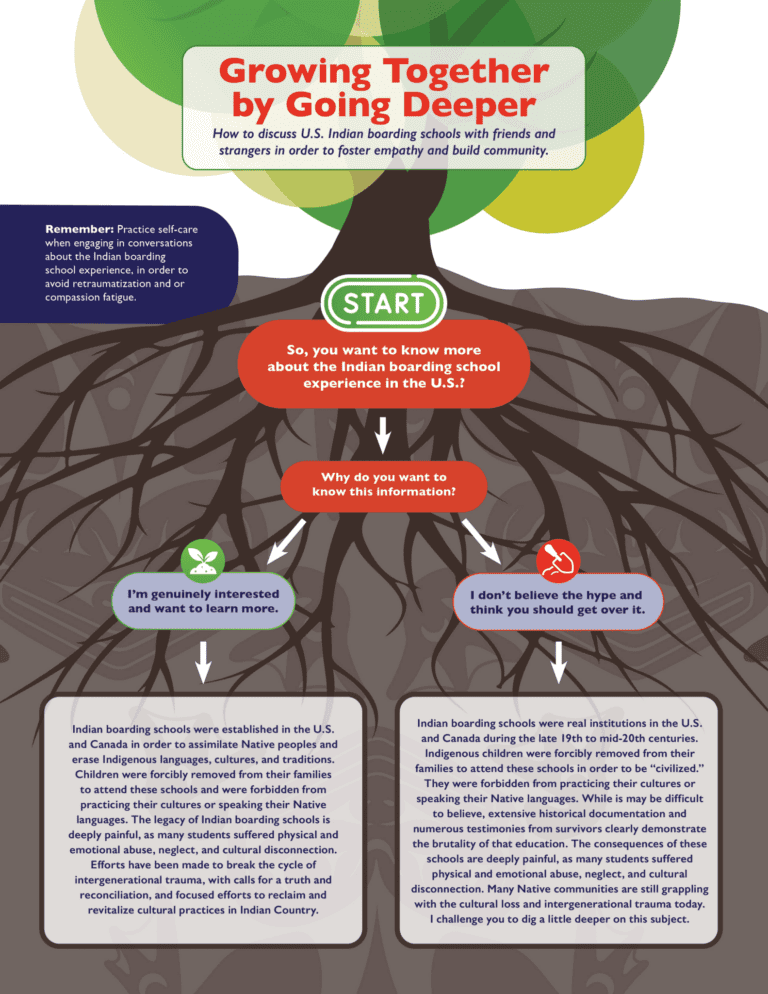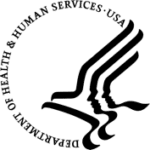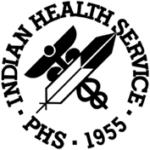Discussions about U.S. history and the experience of AI/AN children who attended Indian mission and U.S. Indian boarding schools is important not only to gain a greater understanding of history but because of the impact it has on AI/AN people today.
This toolkit includes examples and best practices on how to have these difficult conversations. This includes knowing where to begin and understanding and preparing for potential “activators” or re-experiencing for individuals who might have direct or generational trauma associated with boarding schools. Also included are some practical tools to start or manage the conversations and basic-level interactions to focus and apply resiliency factors.
It is also important to know how to guide discussions with those who do not have direct experience with AI/AN culture and history, or who are unaware of the historical and inter-generational trauma impacts of boarding schools in Indian Country.
Discussions with Children and Youth
Often adults try to protect children by not discussing difficult or emotional topics. When adults avoid these topics, children and youth need to fill in the blanks themselves. They may not have the emotional or cognitive abilities to fully understand the information they are hearing or finding themselves through media, or websites. Therefore, it is essential that adults serve as their guides and help young people navigate traumatic histories and events.
How to talk about the Tribal Boarding School Toolkit for Healing
Focus on Repair and Resilience
Discussions should move beyond being trauma informed to focusing on being healing centered. This approach acknowledges that people are more than their traumatic experiences and emphasizes the possibilities for well-being. Dr. Shawn Ginwright’s model for healing centered engagement can be a useful framework for these discussions. The framework provides a strengths-based social emotional learning strategy that includes five main elements: culture, agency, relationships, meaning, and aspirations.
Teach the Accurate History of Indian Boarding Schools
The National Native American Boarding School Healing Coalition offers developmentally appropriate curricula for students in elementary through high school. When teaching the history of boarding schools:
- Stick to the facts while explaining the government policies that lead to the creation of the schools, the experiences of the children who attended them, and the lasting impact on AI/AN communities.
- Provide information in small accessible developmentally appropriate chunks.
- Watch for signs students are disengaging or need time to process their emotions.
- Take breaks as needed and leave lots of time for questions and reflection.
Check Your Biases
While preparing for the discussion, make sure to check your biases, and process your emotional reaction to the content. Remember it is okay to not have all the answers to young people’s questions. Remain humble, and model for them that it’s okay not to know how to find the answer they seek. And that it’s okay to have an emotional reaction to difficult content.
Center the Assets and Strength of AI/AN People
While it is important to acknowledge the intergenerational trauma caused by boarding schools, it is also important to highlight the individual and collective strength and resilience of AI/AN people. Share stories, music, art, and accomplishments of historical and contemporary AI/AN people.
Create a Safe Space
Create a safe space for youth and children to express their thoughts and feelings. Be patient and make sure students feel safe sharing reactions to what they are learning. Provide opportunities for them to share ideas about how to promote healing. They might not have the words to fully express what they feel about the harm caused (Riley & Hayes, 2018), or they may need time to process. You can give space for processing by offering options including discussion, music, art, or play.
Offer Support and Resources
Let youth and children know they are not alone and that there are resources available to support them; and that there are opportunities to take action. Create a resource list of books, websites, support groups, or invite elders to serve as facilitators of additional conversations.
"Growing Together" Discussion Chart

Reservation Dogs: Deer Lady – Discussion Guide
Reservation Dogs: Deer Lady – Discussion Guide
Season 3: Episode 3
How to use this guide: The questions below are meant to serve as prompts, not a script. Please feel free to change the language to best suit the participants in your group. We also encourage you to follow the natural flow of the conversation and only bring in additional prompts when the discussion seems to be losing steam. Please be mindful of any stress or trauma reactions AI/AN participants may be experiencing. The goal of these discussions is to move from being trauma-informed to healing-centered.
“They can’t stop you from smiling.” – Deer Lady
Deer Lady
- What do you already know about the Deer Lady (or Deer Woman) legend?
- Why do you think the writers felt that Deer Lady should be in this episode?
- Why does Bear stay safe during his time with Deer Lady?
- Did Deer Lady’s actions right a wrong? Why or why not?
General Prompts
- What emotions came up for you while watching this episode?
- What stereotypes were confronted in this episode?
- What did you learn about the role of the priests and nuns at the boarding schools?
- Why did the priest tell Deer Lady that “Most men who live like me are dead by now?”
- What questions do you have after watching? Where can you look to get those questions answered?
Prompt for Discussions with AI/AN Peoples
- In what ways can this type of media help us heal?
- What are the benefits or risks of bringing these hard conversations to more mainstream audiences?
Throughout this toolkit, sections are emphasized for simple and quick referencing with the following icons:
Call to Action
Activities for users of the toolkit to implement in their communities and with their clients.
Highlights
Important information for users of the toolkit to keep in mind.
Experiential Therapies
Creative outlets or practices that are proven to assistwith healing from trauma.



